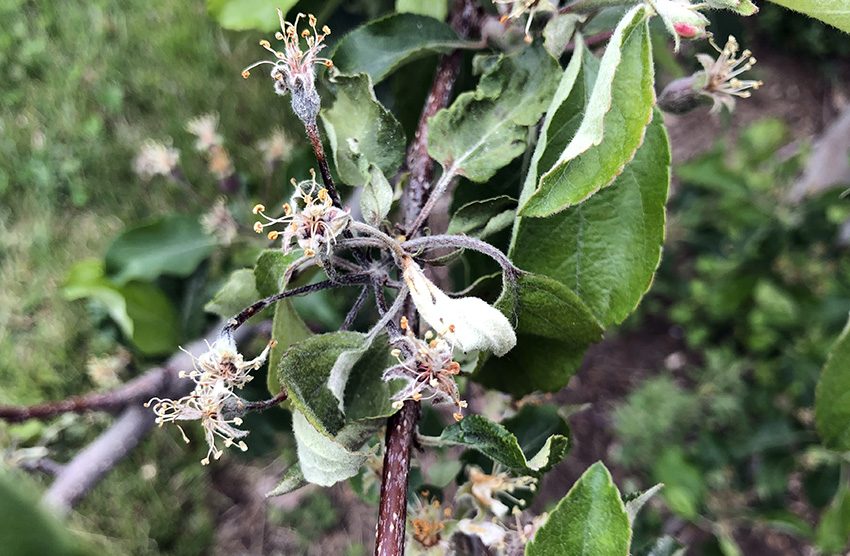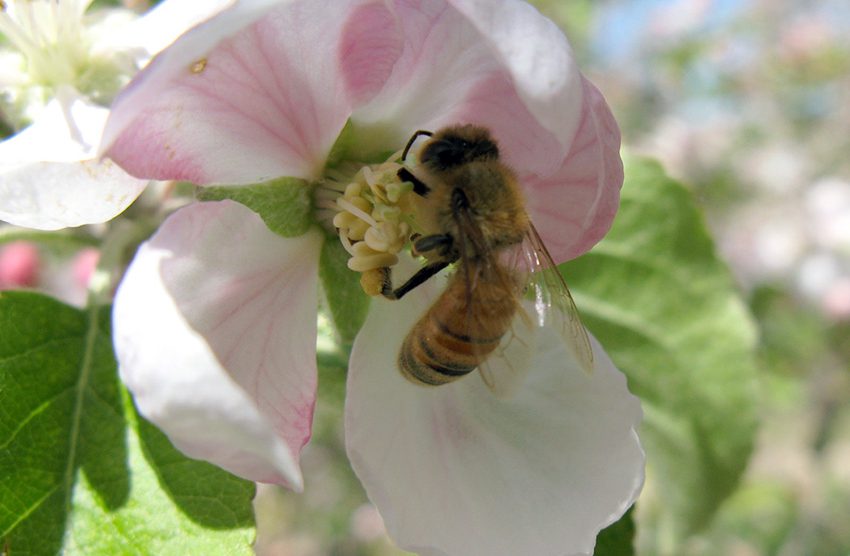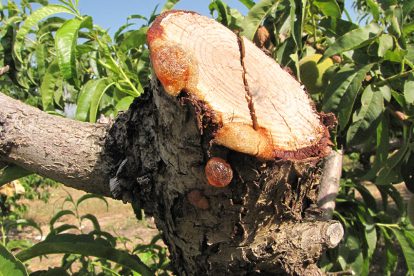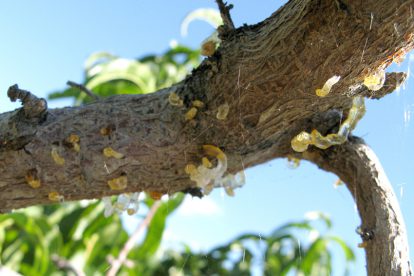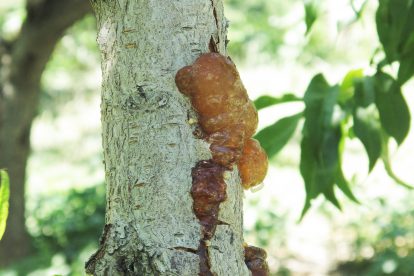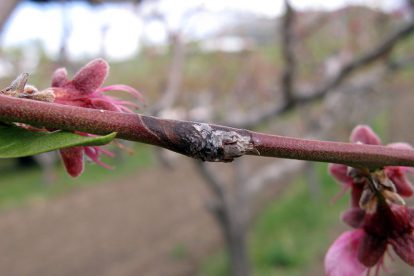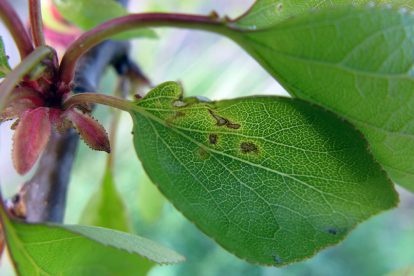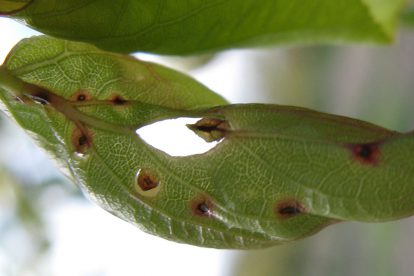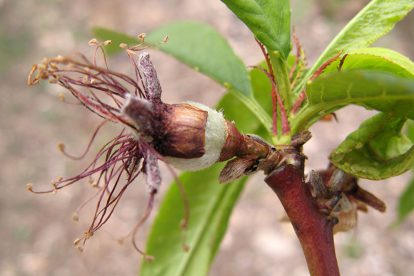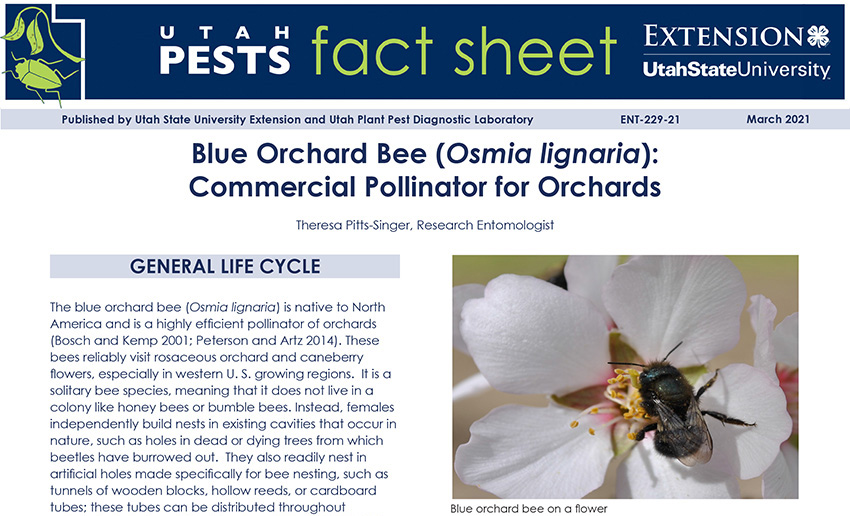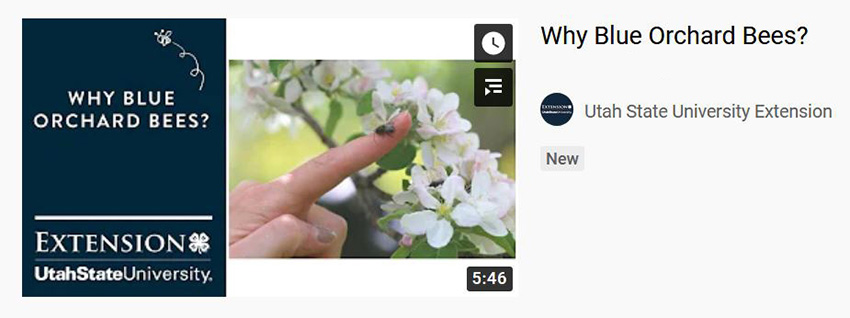In this Issue:
- Apple, Pear: fire blight, southern Utah codling moth dates, and powdery mildew
- Peach/Nectarine, Apricot, Plum: gummosis (cytospora canker), coryneum blight, nectarine scarring
- Blue Orchard Bee Resources
APPLE, PEAR
Fire Blight
risk is high; infections may happen on blossoms in warm, wet weather
During apple and pear bloom, fire blight infections are a risk when conditions are warm and wet. For most areas of Utah, the risk of fire blight is HIGH to EXTREME through May 4. The risk is determined from a formula that is based on temperatures over the past 4 days.
Remember that open blossoms are required for infection. In addition, moisture is required, so check your local forecast to see if rain (or heavy morning dew) is predicted. Irrigation can also contribute to spread.
If you have trees or orchards that were affected by fire blight in the past, consider an antibiotic application today or tomorrow, with a re-application on Monday or Tuesday, if there are flowers and a chance of moisture.
You can watch fire blight predictions on Utah TRAPs by selecting a location closest to you, and then selecting “fire blight” under the Pest drop down menu.
Treatment
- For commercial producers, most areas (except the southern part of Utah County, which has resistance) can use streptomycin. Where resistance occurs, producers should use oxytetracycline (MycoShield) and/or Kasumin. One application can be a mix of oxytetracycline and streptomycin.
- Most diligent backyard growers should not need to apply an antibiotic. (Although if necessary, most garden centers carry streptomycin.) Instead, monitor trees closely starting two weeks after full bloom (which is when infections start to become visible). Prune out new infections immediately (on a dry day).
Codling Moth
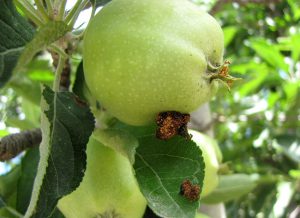
no action to take now in northern Utah; dates in southern Utah shown below
To determine the codling moth spray dates, we hang monitoring traps in Utah orchards. Once those traps catch moths, we can then run the calculations to determine the dates. As of now, we have not caught any moths yet in northern Utah. However, warmer weather is coming, and we will provide the information as soon as we know.
For southern Utah locations, the dates to apply your first spray of the season are shown below. Options of spray materials can be found on the codling moth table on this post.
- Washington County: May 7-8
- Zions Canyon area (Springdale): May 1-3
- Moab area: May 19-20
- Kanab area: May 24-25
Apple Powdery Mildew
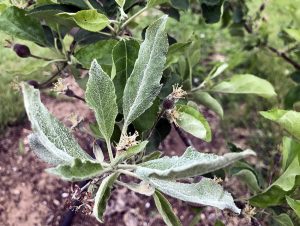
apply fungicide after bloom
Apple powdery mildew overwinters on twigs, and as a result, new infections can occur very early in the season. If left untreated, new infections can occur all summer long, just from humidity within the tree canopy.
If your apples have had powdery mildew in the past, look for infections now. If trees are in bloom, and you find powdery mildew, consider a fungicide application after bloom, with a second application about 5 to 14 days later, depending on the product used (see below).
Cortland, Idared, Gingergold, Braeburn, Gala, and Jonagold are all varieties that are more susceptible.
Treatment
Commercial growers: treatment options are shown by clicking here. For each product, there is a range of days after the treatment name that shows how long the protection interval lasts.
Residential growers can use:
- Spectracide Immunox: separate applications by at least 14 days and apply as needed
- Sulfur (organic; many brands): apply every 10 days as needed
- Neem oil or 1% horticultural oil (organic; many brands): apply every 3 to 5 days as needed, but not when temperatures will reach 85 F within 4 hours of application
- Potassium bicarbonate (organic; Monterey Bi-Carb, Garden-Ville): apply every 7 days as needed
PEACH/NECTARINE, APRICOT, PLUM
Gummosis
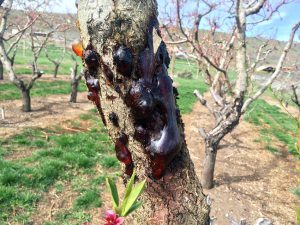
prune out infected branches
Gumming on stone fruits (peach, apricot, plum) is very common, and most evident in spring as the sap starts to flow. The oozing of gum is generically referred to as gummosis and it can be clear or dark amber in color. By the end of the summer, it will have become almost rock-hard.
The most common cause of gumming on stone fruits is a disease called cytospora canker. It is caused by a fungus (Cytospora) that infects bark through an existing wound such as pruning cuts, sunscald injury, cold injury, hail, deer rubs, etc. The pathogen kills the bark and underlying wood, and the tree oozes gum at the infection site as a defensive measure.
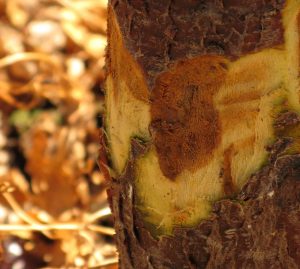
Gumming from cytospora is dark amber in color, and if you scrape the bark off, the dead phloem will appear cinnamon brown in color. Cytospora canker is very common in Utah’s peach and apricot orchards, as well as on backyard trees.
Prevention is the key to managing Cytospora
- In normal pruning operations, make proper cuts (i.e., do not leave stubs or do not make “flat cuts” that remove the branch collar where healing would normally occur) and do not prune in wet weather. Pruning the Orchard
- Protect the bark during winter from sunscald. Either apply white tree wrap from December to March, or paint the trunk (anytime) with 50/50 latex paint/water;
- Prune out infected limbs and twigs back to healthy wood, and sterilize tools with 10% bleach or Lysol wipes between cuts. Sometimes it is not possible to remove all infected limbs. In that case, be diligent about tree health, sanitation, and regular pruning practices.
- Remove severely affected trees from the orchard or backyard.
- Keep trees healthy with optimal watering, mulching, nutrition, etc.
- An excellent bulletin on Preventive Control of Cytospora Canker is available from Colorado State University.
Other Causes of Gumming
- Thick gumming at the base of the tree (no higher than 8-12”): Greater peachtree borer. Trees can be protected with a properly timed insecticide, typically in late June (we will include dates in a future advisory).
- Small areas of ooze, throughout the tree: Borers. Flatheaded or shothole borers will only attack weakened trees or wounds such as where sunscald has occurred. Usually there is very little ooze associated with these insects because the trees are already weakened. If the borers attack healthy trees, however, the tree will exude copious sap/ooze to flush out the larvae. This ooze is often clear in color, and limited to beetle entry holes. Management of these pests is difficult, and may include bark sprays of permethrin May through August.
- Random pattern of gumming: Wounds or other cause. Gummosis not caused by a pathogen will run somewhat clear in color (but will dry to amber). Wounds include frost cracks or sun scald, bark injury, cat scratching, hail, etc. Other causes include planting too deep, excessive irrigation, severe summer pruning, or over-bearing.
If you are not sure that a pathogen is causing the gummosis, scrape the outer bark away. If the inner bark is still cream-colored (healthy), the oozing is caused by a non-living factor, and there is nothing you should do. If the wood is tan to brown, it is dead, and was most likely killed by a pathogen.

Coryneum Blight (Shothole)
apricot, peach – fungicide application at shuck split stage (see image)
The main symptom of coryneum blight (shothole) that concerns growers is damage to the fruit skin in the form of purple spotting, scabs, or sunken lesions.
If coryneum blight is a problem on your peach, nectarine, or apricot trees, note that one of the most important times to apply a fungicide is after bloom, at the shuck split stage (see image above).
This pathogen is spread primarily by rain, and optimal conditions for infection are when temperatures are from 70 to 80°F.
Treatment
Commercial growers can find options by clicking here.
Backyard growers can use one of the following:
- Spectracide Immunox
- product containing chlorothalonil (Daconil, for example. Note that chlorothalonil cannot be used after shuck split while fruit is still on the tree.)
- Captan
Nectarine and Plum Scarring (Western Flower Thrips)
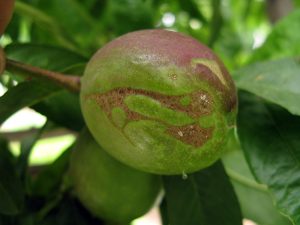
application of spinosad at late bloom to petal fall in evening
Thrips are tiny insects whose feeding inside the flower can result in deformed nectarine and plum fruits. Thrips feed on the developing fruit from bloom time to petal fall. As the fruit matures, scars form from the feeding wounds and oozing gum may be associated with the scars.
Treatment
To prevent thrips injury, spray spinosad (many brands; organic) during or right after bloom. Treat at night or early in the morning because spinosad is harmful to bees when the product is wet (the dry product does not affect bees). Just one application with thorough coverage is needed.
OTHER INFORMATION
Blue Orchard Bees for Commercial Pollination
Entomologists at the USDA Bee Biology and Systematics Research Lab (“The Bee Lab”) in Logan, UT and the Foothill Bee Ranch in California, have prepared a fact sheet and a series of videos on rearing blue orchard bees for pollination.
The fact sheet explains management of blue orchard bees for commercial orchards, including temperature management, stocking density, nesting requirements, and more.
The informative videos range from 3 to 6 minutes each:
- Why Blue Orchard Bees? explains the life cycle of the bees, and the advantages of using them for pollination.
- How to Provide Blue Orchard Bee Nesting Materials explains the recommended timing for deploying nesting tubes, where to hang them, and how high to hang them in orchard trees.
- Types of Blue Orchard Bee Nesting Boxes and Common Nesting Materials for Blue Orchard Bees both show several options for nesting structures and materials, from straws to tubes to wood blocks, for large and small orchard operations.
- Cleaning Blue Orchard Bee Laminate Nests provides a step-by-step visual guide to separate diseased cocoons from healthy cocoons, and how to identify other cocoons that might be in the nests.
- How to Remove Blue Orchard Bee Nesting Materials shows how to remove paper straws from cardboard tubes or wood blocks, and the best way to open the straws and remove the cocoons.
- How to Wash Blue Orchard Bee Cocoons explains how to clean cocoons in bleach water after they have all been removed from their nesting tubes.

